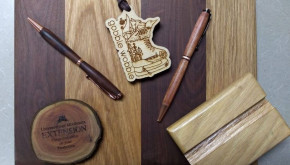
Have you ever noticed a beautify wooden piece at the antique store or craft fair and wondered, "What kind of wood it this that?" I'm the lady that regularly walks into a house and checks out the floors to see if they’re oak, maple or hickory. I love wood and I enjoy the challenge of trying to figure-out what types of wood are in the world around me.
Wood identification isn’t easy, but there are a few basic tips that can help and the University of Tennessee has a great, relatively easy to understand, resource to help: Wood Identification for Hardwood and Softwood Species Native to Tennessee. As the title implies, this is only for tree species native to the eastern US, but that covers many of the most common woods: hardwoods like oak, maple, hickory and basswood; and softwoods including pine, spruce and fir.
Now a note to the perfectionists among us: wood identification to species can be tricky or impossible, so starting by looking for a few common wood species. I’m not going to repeat the great information in the UT link, but rather offer a few quick tips.
First, wood ID is usually easiest if you can see the end of the piece, were the growth rings are visible. Also, a smooth cut is important to see small details in the growth rings and various wood pore structures. However, if you have bark, or a large piece and see the knots, those can be important tips too.
Hardwood trees, trees that lose their leaves in the fall, have vessels. Vessels are little cells that look like the drinking end of a straw. Softwood trees, trees that produce cones, have resin channels but no vessels. So start by looking for vessels; if you find them you have a hardwood.
In oaks, elms, and ash trees, the vessels are easily visible and are divided into early wood (large vessels when the tree is growing quickly) and late wood (small vessels when the tree is growing slowly). These are called ring porous woods because the rings are so big and obvious, and in in some cases actually porus!
Fun fact: Only white oak species (bur, white, swamp white and other oak trees with smooth, not pointed, leaves) are used to make wine and whiskey barrels because the ring pores of white oak species are filled with tyloses. Red oak species (oak species with pointed leaves) don’t have tyloses filling their pores and the liquid would leak out of the bottom!
Look for vessels. If you find vessels, you have a hardwood species.
For now, I’m going to stop. If I get a few interested comments I’ll create a next installment of wood ID and discuss how to tell oak from ash and introduce diffuse porous species like maple and yellow popular.

